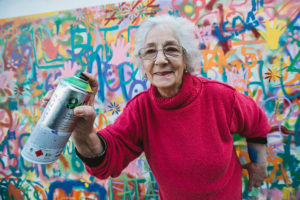Art therapy and sensory stimulation are quickly gaining traction in the Lewy Body Dementia community for their ability to stimulate memory, language and cognition in seniors with LBD – even in advanced cases.
Understanding Art Therapy and Sensory Stimulation
Sensory stimulation uses everyday objects, including art tools, to stimulate one or more of the five senses (hearing, sight, smell, taste and touch). It gives people with LBD and other types of dementia a way to communicate, trigger emotions and memories and improve their mood.
Art therapy uses drawing, painting, visual art, playing with clay and other activities with the goal of improving a person with LBD’s mood and well-being. The extent of the activities depends on a person’s cognitive ability and strength, but can be enjoyed to some degree by individuals at every stage of LBD or dementia.
7 Benefits of Art Therapy and Sensory Stimulation
Combat cognitive decline – Both therapies combat cognitive decline by encouraging the brain to think creatively and develop new pathways.
Improved communication – They offer a new way for people with LBD to communicate, increasing their quality of living and easing frustration. Drawing, photos and painting are some of the preferred tools for communication. Therapy is also a great time to socialize!
Boost self-esteem – Creating or enjoying art or having success with sensory stimulation have been proven to increase self-esteem, mood, overall well-being and creativity.
Reduce aggressive behavior – Art therapy provides people with LBD an outlet for frustration, confusion and aggressive behavior.
Build strength – Holding a paintbrush and other art utensils, working rarely used muscles in the hand and fingers and interacting with sensory tools is a positive way to help people with LBD build new muscle or retain strength.
Improved relationships – Art therapy and sensory stimulation offer people with dementia an outlet for anger, frustration, confusing and aggressive behavior, meaning more positive interactions with loved ones and caregivers.
Trigger old memories – Stimulating one or more of the five senses is a great way to help someone with LBD or dementia evoke dormant memories and emotions. These revelations often lead to meaningful conversations with caregivers.
Art therapy and sensory stimulation come in many different forms. Some of the most common techniques used to stimulate a sensory reaction include making art, aromatherapy, tasting, listening to music, movies, exercise, yoga and visual art. Art therapy usually involves painting, sculpting, visual art, drawing, finger and hand exercise, depending on the severity of a person’s dementia. People that can create art tend to get the best results from art therapy.
Many museums offer free or low-cost programming for people with dementia and their families. Learn more about LBD programming at the Museum of Modern Art and other organizations in the New York area



Thank You. Great information. Who do I contact to learn more?